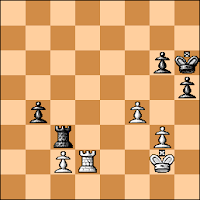?!?!?
I'll admit that sometimes when I examine "secrets" in the Jerome Gambit - recommended moves that have not, or have barely, seen the light of day, or lines that are obscure - it can seem as if things remain concealed, even after my work. Consider the following.1.e4 e5 2.Nf3 Nc6 3.Bc4 Bc5 4.Bxf7+
4...Kxf7 5.Nxe5+ Kf8
Black messes with White's plans by bringing his King to safety, instead of taking a second piece. The Database has 212 games with this position, and White scores 54%. Stockfish 9 sees Black as less than a pawn ahead (depth of search 32 ply).
6.Nxc6 dxc6 7.O-O Bd6
Black clearly has aggressive intentions, as he points his dark-squared Bishop toward the enemy Kingside.
I was surprised to find only 2 games in The Database with this move, one being perrypawnpusher - Lark, blitz, FICS, 2009 (1-0, 18).
By the way, Stockfish 9's suggested line of play, after a long "thought", instead of the text, is 7...g6 8.d3 Kg7. Recommending simply castling-by-hand in such a fluid position is not a lot of guidance for Black, and certainly should be encouraging for White.
8.f4
One finesse in the Jerome Gambit that can often test the first player is which pawn to move first, the f-pawn or the d-pawn?
I am pleased to see that jfhumphrey chose the more accurate 8.d4 in his FICS blitz game again kirtz in 2012: 8.d4 Be6 9.e5 Be7 10.f4 Ke8?! 11.f5 Bd5 12.Qh5+ Bf7 13.Qg4 h5 14.Qxg7 Rh6? 15.Bxh6 Black resigned
Of course, I chose the text.
It is maddening to see that if you give Stockfish 9 a lot of time to think - 49 ply! - it suggests 8.d4 for White, and then 8...g6 (blah) for Black.
Certainly a human player is more likely to answer 8.d4 with 8...Qh5!? White should continue with 9.f4, taking advantage of the chance to form a "Jerome pawn" center. He can then counter 9...c5 with 10.c3 and then answer 10...c6 with 11.Qd3. After that, the computer likes 11...Bc7 12.Nd2 Nf6 13.e5 Nd5 14.f5 cxd4 15.cxd4
analysis diagram
White's "Jerome pawns" are on the march and are holding Black's two Bishops in check, at least for now. When White plays Nf3, it will challenge the placement of Black's Queen, after all. The position is dynamically equal.
So, of course, the computer recommends 15...Nb4 16.Qc4 Nd5 17.Qd3 Nb4, etc. with a draw by repetition of position.
By the way, my game continued
8...g6
Okay, maybe there is something to that move.
9.d4 Bd7
Stockfish 9 prefers 9...Kg7 10.Nc3 Qh4 11.Qd3 Nh6 12.h3 Bd7 with an even game. Much of that should look familiar by now.
10.Nc3
Also playable are 10.e5 and 10.Be3, although I kind of like 10.c4!? - although it might be too much of a good thing.
The game finished up with: 10...Nh6 11.f5 Qh4 12.e5 Nxf5 13.exd6 cxd6 14.g4 Re8 15.gxf5 Bxf5 16.Qf3 Qxd4+ 17.Kh1 Kg7 18.Qf2 Black resigned




















































